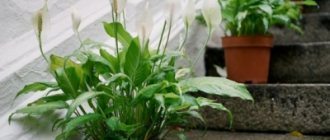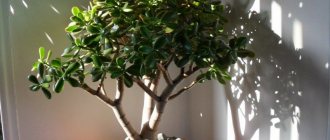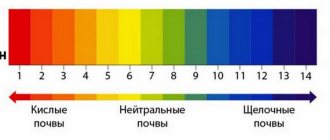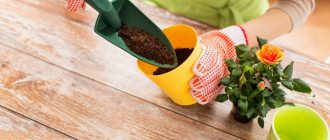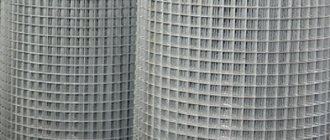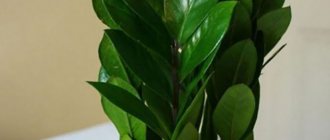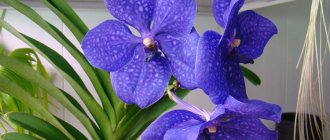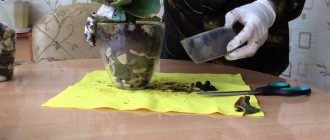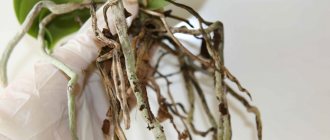Land for Zamioculcas - what kind is needed
The main requirement that this flower places on the soil is good breathability. The most suitable combination is turf soil and sand with the addition of small pebbles or expanded clay.
This mixture will provide the rhizome with the maximum amount of oxygen for normal growth and development. Thus, it is not recommended to use loamy soils with a high level of humus for planting dollar trees. Such a mixture can lead to root rotting due to its ability to retain water for a long time.
If you use self-prepared soil rather than purchased soil, it is recommended to thoroughly disinfect the mixture before direct planting. This can be done by pouring boiling water over the substrate, or by placing it in the oven for a while.
Is soil suitable for zamioculcas for cacti, what kind of soil is better to buy?
If you don’t have the opportunity or lack the experience to make your own substrate, don’t despair. You can purchase a ready-made mixture at any specialty store.
The most common ones include:
- Soil for cacti and succulents - provides good breathability, which is important for the normal growth and development of the flower;
- A universal substrate mixed with sand and a small amount of expanded clay or perlite. These mixtures are in no way inferior in quality to those made by hand.
In addition, store-bought mixtures can be a real salvation for a novice gardener, because they will reduce the risk of making a mistake and destroying the plant to a minimum.
Suitable composition
The main requirement for soil for zamioculcas is sufficient air permeability. The soil should be loose and fluffy. Compliance with these characteristics can be achieved by mixing the following components in equal proportions:
- turf; sand;
- peat soil with weak acidity;
- leaf soil.
This substrate can be used when planting a purchased plant in a permanent pot, and for replanting in the future.
Before transplanting, the pot must be filled with drainage to 1/5-1/4 part. For these purposes, you can use purchased mixtures, or prepare the material yourself from stones, broken bricks, shards and other objects that drain the soil well. When choosing which soil to plant a plant in, you can also consider ready-made options that are easy to purchase in specialized stores for flower growers.
How to choose ready-made soil
If, when choosing a substrate for zamioculcas, you pay attention to the finished soil, the following will be suitable for this flowerpot: universal soil for indoor plants; soil for cacti and succulents. A universal ready-made substrate has both pros and cons.
Advantages:
- no time spent on preparation;
- In the finished soil, all substances are combined in the required proportions.
Flaws:
- when purchasing ready-made soil, it is impossible to accurately select the components depending on the individual qualities of the plant;
- It is better to supplement a universal substrate for indoor plants with additives in the form of expanded clay, coal and sand, which you will have to add yourself.
When buying ready-made soil, you need to pay attention first of all to the composition. It should list all the components necessary for zamioculcas in quantitative terms or in percentages relative to the total mass. When choosing soil, you need to pay attention to the release date of the package and its expiration date. Upon visual inspection, there should be no mold films on the surface, and when feeling the package, there should be no straws.
What additives should be added to the soil for Zamioculcas?
The main property that substrate additives should have is loosening. The soil must be breathable and fully saturated with oxygen, as a result of which moisture will also be evenly distributed.
You can add the following to the soil for zamioculcas:
- vermiculite;
- expanded clay in small fractions;
- perlite;
- sphagnum;
- coarse river sand.
These materials serve their main purpose well, while also improving the quality of the soil.
An excellent solution would be to use several types of soil. You can take soil from the garden, from the garden, leaf or turf soil.
How to propagate a dollar tree at home
The “flower of celibacy” can be propagated during transplantation and at the stage of plant extinction. This can be done in several ways: dividing the bush, cuttings and rooting the leaf.
The best time for reproduction is spring or summer.
Dividing the bush
The longest propagation process and is not used as often as cuttings or rooting of a leaf blade. This method can be used when replanting a plant. To do this, the “tree of luck” is carefully removed from the pot and the tubers are examined. If there are buds on them, then use a sharp knife to divide the tuber so that each part has its own growing point. The cut site is treated with green paint or charcoal and planted in prepared soil.
The cuttings are planted in nutritious, well-drained soil.
Cuttings
A plant that is at least 2 years old can be propagated by cuttings. To do this, cut apical cuttings 20 cm long. For better rooting, the lower leaves are removed, and the leaf plate of the upper ones is cut by ½. It is better to treat the cut with Kornevin or Epin, keep the cutting in the open air to dry the cut, and then plant it in the ground. For the first 2 weeks, the plant must be watered frequently and abundantly. Once rooting begins, water only as needed.
The first sign of rooting is the appearance of new leaves
Rooting leaf blades
When it is not possible to separate the cutting from the plant, you can propagate it using a leaf in two ways: rooting in water or soil.
In nutrient soil
A simple and easy method, which is very similar to cuttings. For this method, a leaf plate is cut from the bottom of the plant, sprinkled with wood ash and kept in a root formation stimulator. I plant the prepared leaves in separate pots, water them well and put them in a warm, bright place.
If the temperature and humidity conditions are observed, roots appear on the 14th day
In water
An easy method of propagation, but the plant grows small and weak. To root in this way, healthy leaves are cut from the “money tree” and placed in a container with water so that they stand horizontally. For better rooting, you can add a root formation stimulator to the water. As soon as the first roots appear, the plant can be planted in prepared soil.
The method is ideal for beginners
Three types of soil for Zamioculcas
What kind of soil is needed for the plant? Its composition may vary.
Mix 1
To plant zamioculcas, it is quite possible to mix two types of soil, for example, leaf and turf. If you add a little peat soil to this mixture (all ingredients are taken in equal proportions), then the composition as a whole will have very good characteristics.
Mix 2
This composition will also work. Take turf soil, mix it with sand, then add a little expanded clay and small crushed stone to the mixture.
Mix 3
Take equal parts of turf soil, leaf soil, part of the peat and add sifted sand.
Additional primer ingredients
In general, the dollar tree likes to “bask” in light and loose soil . Water and air must circulate freely through the layers of the earth. The following work well as loosening agents for any soil:
- River sand (preferably large), expanded clay pebbles (preferably small).
- Vermiculite , for example, is excellent at retaining moisture. In addition, it completely lacks an environment favorable for the growth of mold or mildew. It is excellent drainage. You can add it to the soil in any proportions.
- Perlite is also able to distribute moisture in the soil and protects the top soil layer from the formation of a dry crust.
- Sphagnum peat moss (translated from Greek as “natural sponge”) is unique. Sphagnum moss, even when wet, allows air to pass through it well. In addition, it has excellent antibacterial properties. This means that adding it to the soil can protect it from infection.
Thus, adding the above additives to the soil for zamioculcas perfectly heals and loosens the soil, and, accordingly, contributes to better plant growth.
Soil pre-treatment
After preparing the earthen mixture, it must be processed for disinfection purposes. The substrate for zamioculcas does not require chemicals, since sterilization can be carried out by exposure to high temperature.
There are 3 main processing methods:
- pouring boiling water over;
- sterilization in a water bath for 1.5 hours;
- Heating in the oven for 30 minutes at 70–90°C.
Primary chemical treatment
ATTENTION! It is not the soil that is treated with chemicals, but the branches of zamioculcas directly in case they are infected with spider mites, aphids or scale insects.
Spraying with a sulfate-nicotine solution will save you from aphids. It is better to disinfect leaves with a cotton swab previously soaked in the solution. One gram of the drug should be diluted in a liter of soapy water. Other pests can be dealt with by an infusion of tobacco or a soap-tobacco solution with alcohol.
How to cook it yourself?
If you are planning to plant or replant a dollar tree and there is no way to go to a specialized store for a substrate for a succulent, then preparing a soil mixture suitable for zamioculcas will not be difficult , you just need to know what kind of soil is suitable.
To plant young plants at home:
- We combine 1 part of the turf soil with the same amount of sand, expanded clay and small crushed stone.
- Mix all components thoroughly.
For transplantation:
- We combine leaf soil, turf soil, peat and sand, observing the recommended proportion of 1:1:1:1.
- Mix everything thoroughly until a homogeneous mixture is formed.
Another option: mix equal amounts of leaf and turf soil with the same volume of vermiculite and sand.
Scheme for mixing soils and additives for preparing soil:
- 1 tsp turf soil,
- 1 tsp leaf,
- 1 tsp slightly acidic peat,
- 1 teaspoon of sand without clay fractions.
Care
In order for Zamioculcas to quickly take root after transplantation and become as strong as possible, it needs to be provided with proper care.
The pot is placed in a shaded, warm place to stimulate the rooting process. Afterwards they are transferred to a permanent place.
The tree can grow both on a well-lit windowsill and in a remote corner of the room. The latter is recommended for large specimens whose growth needs to be stopped.
When located on the south side, the plant is shaded during the hours of sun activity, because exposure to direct rays can cause a burn.
Temperature
Zamioculcas is one of the heat-loving plants.
During the growing season, the regime must be maintained at 25-30 degrees. In winter, the readings drop to 15 degrees.
Humidity
It is allowed to systematically spray the foliage with a sprayer in order to eliminate settled dust.
Afterwards, it is recommended to wipe the leaves, thereby removing excess moisture and cleaning the surface to normalize photosynthesis.
Additionally, Zamioculcas is placed under a warm shower monthly.
Watering
Excess moisture can cause roots to rot.
One of the features of a green pet is its ability to accumulate liquid, thanks to which it can do without additional hydration for a long time.
In summer, irrigation should be plentiful; as the upper part of the substrate dries out, in the dormant stage the procedure is reduced to 2 times every 7 weeks.
Excessive soil moisture coupled with low temperature leads to rotting of the roots and, as a consequence, to the threat of crop death.
If the plant is left for a long time in drought conditions, even when the leaves fall, it is possible to save the plant - it should be watered in small portions, and when new young shoots appear, abundant irrigation should be resumed.
Top dressing
The tree is fed for the first time after transplantation no earlier than 2 weeks. Mineral complexes for succulents are used as preparations. From autumn to spring, fertilizing is completely stopped.
How to determine that a succulent needs to change its substrate?
The first time you need to change the soil for a dollar tree is immediately after purchasing it from a flower shop.
Since the plant is transported from afar, suppliers plant it in a special substrate to preserve its root system. This soil is ideal for transportation, but is in no way intended for the growth and development of zamioculcas.
Further transplants of zamioculcas must be started when, after watering, the water stagnates in the pot on top of the soil. Ideally, a loose substrate, completely entwined with the roots of the plant, will quickly allow moisture to pass through, and it will safely fall into the pan.
A compacted earthen lump is a serious obstacle to the path of water : the liquid is not able to saturate the soil and remains on the surface, which threatens the plant with the formation of rotting areas, and subsequently death. Another signal that the plant needs replanting is roots sticking out of the drainage hole.
Attention! The frequency of planned Zamioculcas transplants directly depends on its age: for a young specimen, the soil should be changed annually, and for an adult – once every 3-4 years.
Do not neglect unscheduled transplants , the need for which may be indicated by the following factors:
- covering the soil surface with mold;
- root rotting;
- suspension of plant growth;
- flower disease;
- damage to the flowerpot.
Description of the flower
The structure of Zamioculcas is very unusual. The Dollar Tree does not have a trunk, stems or branches like other trees. What grows from the soil is a compound leaf that forms directly from the rhizome. The root system of Zamioculcas is a large underground tuber from which thick, worm-like roots extend. The rhizome is so powerful that it can break a hole in the pot if it becomes crowded in it. The tuber plays a huge role in the life of the plant - it accumulates and retains moisture.
The leaves of Zamioculcas are erect, glossy, with a waxy coating. They grow on fleshy petioles thickened at the bottom. The leaves grow from 40 to 60 cm in length. They are complexly pinnate, divided into 8 - 12 separate leaves - feathers. The leaf axis (rachis) is juicy and thick. The petioles and rachis are covered with ink-colored spots. The leaves are feathers that are very dense and leathery.
In appearance, Zamioculcas resembles a very rare cultivated gymnosperm flower - Zamia, which lives on the American continent, which explains the name of the plant - Zamioculcas zamielifolia.
The Dollar Tree grows very slowly. Only a few new leaves appear per year. The growth is about 10 - 15 cm. But with good care, during its life it can reach a meter in height and even higher. In dry times, this evergreen flower can get rid of its leaves - feathers - to avoid excessive evaporation of moisture. The petioles and central vein of the leaf (rachis), at the same time, will remain on the plant. Like tubers, leaves and petioles have the ability to accumulate moisture and nutrients whenever possible - this is how the plant has adapted to long periods of drought in its homeland. The lifespan of this succulent is from five to ten years. If you have one copy, take care of its reproduction in advance.
Bloom
This is how Zamioculcas blooms
Zamioculcas blooms extremely rarely even in its natural conditions, and only in adulthood. In appearance, the Dollar Tree inflorescence looks like a thick cob, which contains small, inconspicuous flowers of a light cream or yellowish hue. The spadix is formed in the lower part of the flower on a short thick peduncle. You won't notice it right away, since it is usually covered with a pale green petal - a blanket. In indoor conditions it blooms only under ideal conditions after three years after planting. The flowering time is most often at the end of spring, but sometimes the cob appears at the end of autumn, before the onset of cold weather. Flowering is long lasting. The aroma is fragrant, pleasant. But the seeds do not set even with artificial pollination. Experienced gardeners usually remove the inflorescence early, as it is not of particular interest. In nature, after the flowering of Zamioculcas, berries with one seed in each of them may appear and ripen. It has been noticed that the Dollar Tree usually blooms at the end of its life.
Zamioculcas juice is poisonous. Be careful when working with the plant during replanting, pruning or propagation - wear gloves. If the juice gets on the skin and mucous membranes of the eyes and mouth, it can cause a severe burning sensation. Trying to taste the leaf may cause an upset stomach or an allergic reaction. For this reason, it is worth making the place for growing a flower inaccessible to pets and children.
Transplant tips
It is important to pay attention to the following aspects:
- The best time for transplantation is considered to be March and April, with an optimal amount of heat and a suitable level of lighting;
- When transferring rhizomes to a new container, it is not recommended to completely cover them with soil. This will help avoid waterlogging and, as a result, rotting, which is dangerous for the flower;
- If, during transplantation, rotted roots are found on the root, they must be carefully separated from the general lump to stop the spread of the problem;
- It is recommended to replant zamioculcas in a nutrient substrate, which contains clean sand, peat, leaf soil with the addition of humus in equal proportions. To increase breathability, it is recommended to add crushed expanded clay;
- Before replanting, place a drainage layer of small pebbles or stones at the bottom of the pot;
- It is recommended to water the zamioculcas for the first time no earlier than two days after transplanting the flower into a new container.
After the plant has finally settled into its new pot, it is important to monitor root development. This will help you notice in time the moment when the flower needs to be replanted without harm to it.
Replanting after purchase
Many novice gardeners immediately transplant plants into a new substrate after purchasing them, but in the case of Zamioculcas, this should not be done.
After purchase, it is recommended to follow the following sequence of actions:
- Place the plant in quarantine - place it in a room where there are no other flowers. This event will help you notice disease or pests in time without the risk of infecting other flowers;
- If a disease or parasites are detected, carry out therapy as quickly as possible;
- After two weeks, the flower can be replanted.
"Dollar Tree" - signs and superstitions
Signs and superstitions associated with the “dollar tree” are known throughout the world. By observing zamioculcus, you can safely make a financial forecast for several months. Signs include the following information:
- abundant flowering - unexpected profit (inheritance or winnings);
- plant disease is a harbinger of sudden ruin;
- stable growth – increased income.
Such simple observations will help the plant owner take timely action and protect himself from bankruptcy.
In order for the flower to work in full force, it must be received as a gift
Superstitions associated with the plant:
- If the “dollar tree” was received as a gift, you must pay for it - this is the main rule associated with the tree.
- If you bought the tree yourself, then it needs to be fertilized. In order for a plant to begin to show its magical properties, it needs to often say pleasant words.
- On New Year's holidays, the tree is decorated with chocolate or banknotes. Coins are hung on branches, and a dragon or money frog is placed on top.
- The “money tree” should be located on the southeastern side, since, according to the teachings of Feng Shui, there is energy there that can activate cash flows.
- It is better to give a mature plant, but it is not advisable to give away rooted shoots from your tree. Since with a piece of plant all the wealth leaves the apartment.
- Zamioculcas should only be replanted on a waxing moon. This must be done carefully and in a good mood. If the transplant occurs on the waning Moon, then the financial situation will soon deteriorate.
Dollar Tree operates at its best when it is cared for and loved.

